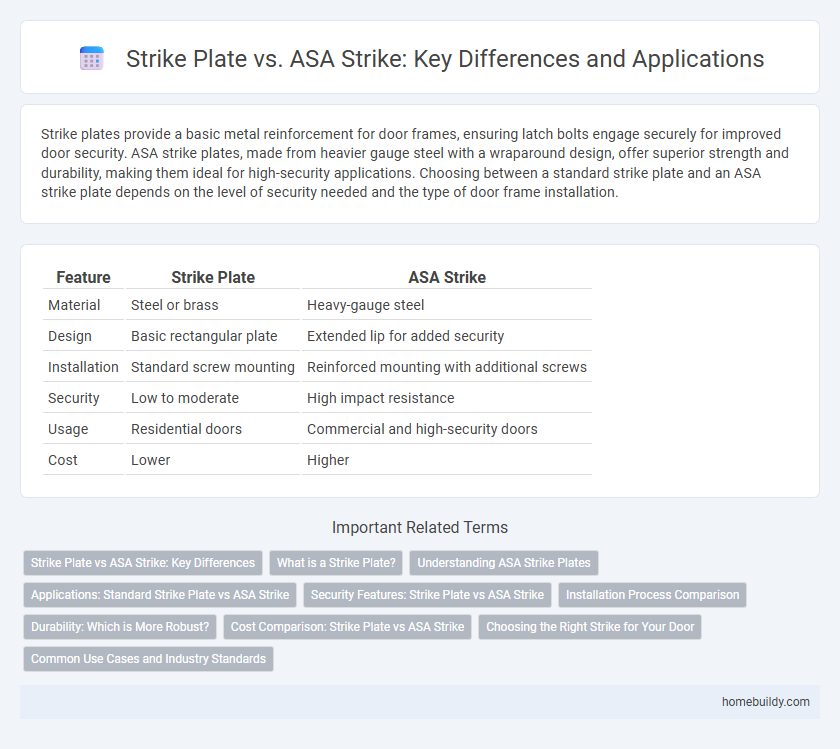Strike plates provide a basic metal reinforcement for door frames, ensuring latch bolts engage securely for improved door security. ASA strike plates, made from heavier gauge steel with a wraparound design, offer superior strength and durability, making them ideal for high-security applications. Choosing between a standard strike plate and an ASA strike plate depends on the level of security needed and the type of door frame installation.
Table of Comparison
| Feature | Strike Plate | ASA Strike |
|---|---|---|
| Material | Steel or brass | Heavy-gauge steel |
| Design | Basic rectangular plate | Extended lip for added security |
| Installation | Standard screw mounting | Reinforced mounting with additional screws |
| Security | Low to moderate | High impact resistance |
| Usage | Residential doors | Commercial and high-security doors |
| Cost | Lower | Higher |
Strike Plate vs ASA Strike: Key Differences
Strike plates and ASA strikes serve as crucial components in door hardware, with key differences in design and application. Strike plates are typically flat metal plates with a recessed area to catch the latch, while ASA strikes often feature a deeper lip and reinforced construction for enhanced durability and security. Understanding the distinctions helps in selecting the appropriate strike type for residential or commercial doors to ensure optimal performance and longevity.
What is a Strike Plate?
A strike plate is a metal plate installed on door frames to reinforce the area where the latch or bolt secures the door. ASA strike plates are a specific type designed by the American Standards Association, featuring standardized dimensions for compatibility and enhanced durability. Compared to generic strike plates, ASA strikes offer improved security and easier alignment with door hardware.
Understanding ASA Strike Plates
ASA strike plates are designed with enhanced durability and security features compared to standard strike plates, making them ideal for commercial doors and high-traffic areas. Unlike traditional strike plates, ASA strike plates often include reinforced materials and standardized dimensions that improve compatibility with various locksets. Understanding the specific design elements of ASA strike plates helps in selecting the appropriate hardware to ensure better door reinforcement and resistance to forced entry.
Applications: Standard Strike Plate vs ASA Strike
Standard strike plates are commonly used in residential doors, providing basic reinforcement and alignment for latch bolts. ASA strikes, designed to meet American Standards Association specifications, offer enhanced durability and compatibility with commercial-grade hardware, making them ideal for high-traffic or security-focused applications. The choice between standard and ASA strike plates depends on door type, security requirements, and compliance with commercial building codes.
Security Features: Strike Plate vs ASA Strike
The Strike Plate and ASA Strike differ significantly in security features, with ASA strikes offering enhanced durability through heavy-duty materials like stainless steel, providing greater resistance to forced entry. Strike plates typically secure the latch bolt within a door frame but may lack the reinforced construction of ASA strikes, which include additional features such as expanded lip designs to better absorb impact. ASA strikes are engineered to meet higher security standards, making them ideal for commercial and high-risk applications where maximum protection is essential.
Installation Process Comparison
Strike plate installation typically involves mortising the door frame to ensure a flush fit, requiring precise chiseling for alignment with the latch bolt. ASA strike installation often includes a similar mortising process but may incorporate screw holes for adjustable positioning, enhancing ease of alignment. Both installation methods demand accurate measurements and proper tools, though ASA strikes can offer a slightly more flexible fit due to their design.
Durability: Which is More Robust?
Strike plates and ASA strikes differ significantly in durability, with ASA strikes often made from heavy-duty materials like steel or solid brass to withstand high-impact force and repeated use. Traditional strike plates, typically crafted from lighter metals, offer adequate protection but may show wear faster under heavy-duty conditions. ASA strikes feature reinforced design elements that enhance their robustness, making them a more durable choice for high-traffic or security-sensitive doors.
Cost Comparison: Strike Plate vs ASA Strike
A standard strike plate is generally more cost-effective than an ASA strike due to its simpler design and lower manufacturing costs. ASA strikes, often crafted from heavier gauge steel, provide enhanced durability and security but come at a higher price point. Choosing between the two depends on budget constraints and the desired level of door reinforcement.
Choosing the Right Strike for Your Door
Choosing the right strike plate is crucial for door security and functionality, with ASA strike plates offering enhanced durability due to their steel construction and standardized dimensions. Strike plates vary by material, size, and design, directly impacting door alignment and lock strength. Selecting a strike plate compatible with your lock type and door frame ensures optimal performance and longevity.
Common Use Cases and Industry Standards
Strike plates are commonly used in residential door installations to reinforce door frames and ensure secure latch engagement, conforming to industry standards like BHMA (Builders Hardware Manufacturers Association). ASA strikes, characterized by their elongated rectangular shape and multiple screw holes, are favored in commercial settings for enhanced durability and greater load distribution in high-traffic areas. Both strike plate and ASA strike types comply with ANSI/BHMA standards but serve distinct applications based on security requirements and door frame configurations.
Strike plate vs ASA strike Infographic

 homebuildy.com
homebuildy.com